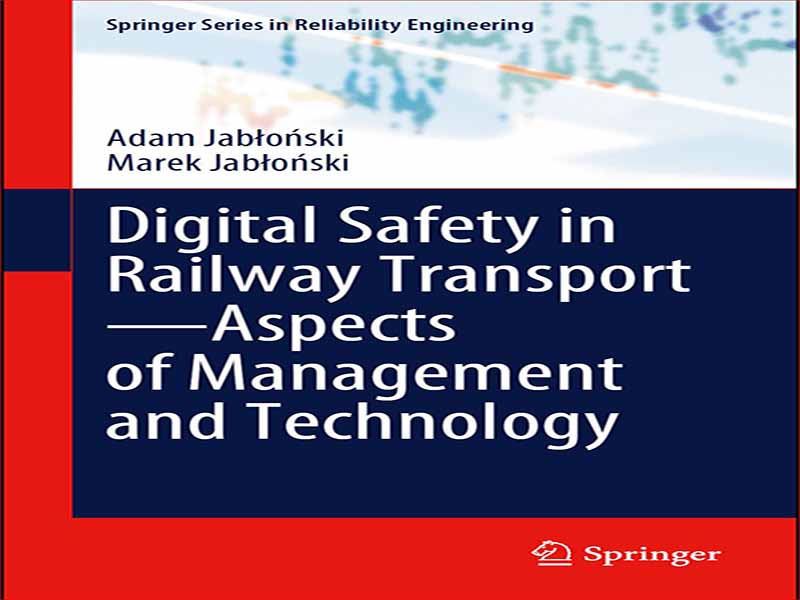- عنوان: Digital Safety in Railway Transport—Aspects of Management and Technology
- نویسنده: Adam-Jabłoński,-Marek-Jabłoński
- حوزه: حمل و نقل ریلی
- سال انتشار: 2022
- تعداد صفحه: 153
- زبان اصلی: انگلیسی
- نوع فایل: pdf
- حجم فایل: 2.31 مگابایت
در زمینه پیشرفت فناوری پویا و در نتیجه توسعه فرآیندهای تبدیل دیجیتال شرکتهای ریلی، نیاز به روشن شدن این موضوع به روشی گسترده برای درک مکانیسمهای امنیت سایبری به عنوان یک چالش کلیدی برای بخش حملونقل ریلی وجود دارد. شرکت های راه آهن که مسئولیت فرآیندهای بهره برداری و نگهداری و جابجایی ایمن افراد و کالاها را بر عهده دارند، باید از خطرات افزایش یافته ناشی از دیجیتالی شدن تمام حوزه های عملیاتی خود آگاه باشند. فرآیندهای دگرگونی دیجیتال پویا شامل عناصر پیکربندی مدلهای تجاری شرکتهای راهآهن و خود سیستم راهآهن جدا شده از نظر هستیشناختی است که به عنوان شبکه راهآهن و وسایل نقلیه راهآهن در نظر گرفته شده برای تردد در آن شبکه شناخته میشود که با ویژگیهای عملکردی و فنی متمایز میشوند. هر دو حوزه در بسیاری از موارد با ایجاد مجموعه پیچیده ای از عناصر مرتبط با یکدیگر همپوشانی دارند، جایی که مدیریت ایمنی ترافیک راه آهن چالش بزرگی را برای دیجیتالی کردن حوزه های عملیاتی شرکت های راه آهن ایجاد می کند. شرکتهای راهآهن با معرفی سیستمهای مدیریتی بر اساس مفهوم مدیریت ریسکهای موجود در عملیات خود، مکانیسمهایی را برای مدیریت ایمنی ترافیک راهآهن ایجاد میکنند. تقسیم ریسک متصدیان بازار ریلی به دلیل جایگاه و نقش آنها در سیستم ریلی است. نوع فعالیت تعیین می کند که تا چه حد عملکرد یک شرکت راه آهن با استفاده از یک مدل تجاری معین بر سطح ایمنی ترافیک راه آهن تأثیر می گذارد. دیجیتالی شدن حوزههای مختلف فعالیت ریلی، بهعنوان یک پدیده گسترده ناشی از نیازهای توسعه خود و شرایط قانونی، باید تضمین کند که تمام فرآیندهایی که به طور مستقیم یا غیرمستقیم با اجرا و بهرهبرداری آن مرتبط هستند، ایمن هستند. با توجه به سطح بالای نوآوری در اقتصاد دیجیتال، پرهیز از هر گونه شک و شبهه ای دشوار است که سیستم راه آهن در شرایط تحول دیجیتال همچنان مانند قبل از دیجیتالی شدن ایمن خواهد بود. بسیاری از تردیدها در این زمینه ناشی از فقدان تجربه عملیاتی گسترده است. بنابراین باید مکانیسمهای استاندارد مدیریت ایمنی دیجیتال را بر اساس نقش آگاهانه مدل تجاری شرکتهای راهآهن و تعبیه این مشکل در زمینه مدیریت، شرایط اجتماعی و فناوری جستجو کرد. ماهیت اجتماعی ایمنی راه آهن ناشی از فشار شدید عمومی برای تضمین سطوح بالای ایمنی ترافیک راه آهن است. شرط حفظ اعتماد در حملونقل ریلی، سرمایهگذاری در بهبود اقدامات کنترل ریسک بهطور فزایندهای است که نه تنها در خود سیستم راهآهن، بلکه در پیکربندی مدلهای تجاری دیجیتالی شرکتهای راهآهن که به طور فزایندهای استفاده میشوند، ایجاد شده است. این مشکل نه تنها از نظر تحقیقات علمی، بلکه کاربرد عملی آن نیز در نظر گرفته می شود، که آن را به یک راه حل ارزشمند برای ذینفعان در بخش حمل و نقل ریلی و همچنین متخصصانی که با فرآیندهای مدیریتی متناسب با شرایط مختلف بخش سروکار دارند، تبدیل می کند. تمرکز بر جنبههای مدیریتی، اجتماعی و فناوری این موضوع را از دیدگاههای بسیاری روشن میکند، که باید خوانندگان را از اهمیت ایمنی دیجیتال در بخش حملونقل ریلی آگاه کند و از چند منظر روشهایی را برای بهبود فرآیندهای مدیریتی آن جستجو کرد. . میان رشته ای بودن این موضوع به این معناست که دامنه ارزیابی انتقادی این موضوع نیازمند نگاهی بسیار گسترده است، همانطور که در این تک نگاری نشان داده شده است. این اثر یکی از نتایج کلیدی سال ها کار نویسندگان در زمینه مدیریت ایمنی در حمل و نقل ریلی، مدل های کسب و کار دیجیتال و جنبه های اجتماعی طراحی مدل های کسب و کار دیجیتال است.
In the context of dynamic technological progress and the resulting development of the digital transformation processes of railway enterprises, there is a need to clarify this issue in a broad way to understand cyber security mechanisms as a key challenge for the rail transport sector. Railway enterprises which are responsible for operation and maintenance processes and the safe movement of people and goods must be aware of the increased risks arising from the digitalization of all their areas of operation. Dynamic digital transformation processes include both the elements of the configuration of the business models of railway enterprises and the ontologically separated railway system itself, understood as the railway network and railway vehicles intended for traffic on that network, distinguished by the functional and technical characteristics. Both areas overlap in many cases by creating a complex set of related elements, where railway traffic safety management poses a major challenge to the digitalization of the areas of operation of railway enterprises. Railway enterprises create mechanisms to manage railway traffic safety by introducing management systems based on the concept of the management of the risks occurring in their operation. The division of risk of rail market operators is due to both their place and role in the railway system. The type of activity determines the extent to which the operation of a railway enterprise using a given business model has an impact on the level of railway traffic safety. The digitalization of different areas of rail activity, as a widespread phenomenon induced by both the needs of its own development and legal conditions, should ensure that all processes directly or indirectly linked to its implementation and operation are safe. Due to the high level of innovation in the digital economy, it is difficult to avoid any doubt that the railway system under the conditions of digital transformation will continue to be as safe as before digitalization. Many doubts in this respect arise from the lack of extensive operational experience. Standardized digital safety management mechanisms should therefore be sought, based on the conscious role of the businessmodel of railway enterprises and the embedment of this problem in the context of management, social and technological conditions. The social nature of railway safety stems from strong public pressure to ensure high levels of railway traffic safety. A condition for maintaining trust in rail transport is to invest in the improvement of increasingly better risk control measures built up not only in the railway system itself, but also in the configuration of increasingly used digital business models of railway enterprises. This problem is considered not only terms of scientific research, but also its practical application, which makes it a valuable solution for stakeholders in the rail transport sector as well as professionals dealing with management processes geared to different sectoral circumstances. The focus on management, social and technological aspects makes this topic clear from many points of view, which should make readers aware of the importance of digital safety in the rail transport sector and from how many perspectives the methods to improve its management processes can be sought. The interdisciplinarity of this subject means that the scope of critical evaluation of this issue requires an extremely broad view, as shown in this monograph. This work is one of the key results of many years of work by the authors in the field of safety management in rail transport, digital business models and the social aspects of designing digital business models.
این کتاب را میتوانید بصورت رایگان از لینک زیر دانلود نمایید.
Download: Digital Safety in Railway Transport—Aspects of Management and Technology


































نظرات کاربران